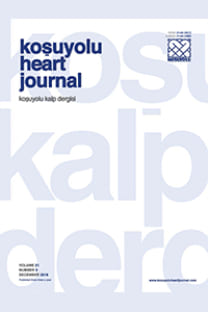Egzersiz Stres Testi ile Tetiklenen Transmural İskemiye Bağlı R Dalga Amplitüdünün Plastisitesi
The Plasticity of R Wave Amplitude Due to Transmural Ischemia Triggered by Exercise Stress Test
___
- 1. Lear SA, Brozic A, Myers JN, Ignaszewski A. Exercise stress testing. An overview of current guidelines. Sports Med 1999;27:285-312.
- 2. Madias JE, Attari M. Exercise-triggered transient R-wave enhancement and ST-segment elevation in II, III, and aVF ECG leads: a testament to the “plasticity” of the QRS complex during ischemia. J Electrocardiol 2004;37:121-6.
- 3. David D, Naito M, Chen CC, Michelson EL, Morganroth J, Schaffenburg M. R- wave amplitude variations during acute experimental myocardial ischemia: an inadequate index for changes in intracardiac volume. Circu lation 1981;63:1364-71.
- 4. Christison GW, Bonoris PE, Greenberg PS, Castellanet MJ, Ellestad MH. Predicting coronary artery disease with treadmill stress testing: changes in R-wave amplitude compared with ST segment depression. J Electro cardiol 1979;12:179-85.
- 5. Bonoris PE, Greenberg PS, Christison GW, Castellanet MJ, Ellestad MH. Evaluation of R wave amplitude changes versus ST-segment depres sion in stress testing. Circulation 1978;57:904-10.
- ISSN: 2149-2972
- Yayın Aralığı: 3
- Başlangıç: 1990
- Yayıncı: Ali Cangül
Egzersiz Stres Testi ile Tetiklenen Transmural İskemiye Bağlı R Dalga Amplitüdünün Plastisitesi
Mert İlker HAYRİOĞLU, Tufan ÇINAR, Vedat ÇİÇEK, Selami DOĞAN, Ahmet Lütfullah ORHAN
Yüksek Dereceli Atriyoventriküler Blok ile Başvuran Hastalarda Akut Böbrek Hasarı Öngördürücüleri
Ayça GÜMÜŞDAĞ, Koray DEMİR, Özlem YILDIRIMTÜRK, Emrah BOZBEYOĞLU, Ömer KOZAN
Ekrem AKSU, Abdullah SÖKMEN, Ahmet Çağrı AYKAN, Bayram ÖZTÜRK, Sami ÖZGÜL, Akif Serhat BALCIOĞLU, Hakan GÜNEŞ
Aykun HAKGÖR, Oğuzhan BODUR, Berhan KESKİN, Seda TANYERİ, Ali KARAGÖZ
Kardiyak Tamponadlı Hastaların Torakoskopik Perikardiyal Pencere Açılma Tarafı Önemli mi?
İlhan KOYUNCU, Mehmet EYÜBOĞLU
Ahmet ELİBOL, Hasan ERDEM, İsmail DEMİR, Cüneyt ARKAN, Dilek YAVUZER
Yenidoğanlarda İntraoperatif Periton Diyaliz Katateri Takılması için Basit ve Güvenli Bir Teknik
